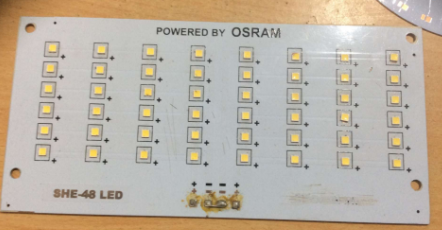This post let’s discuss Top 5 Advantages and Features of Metal Core Printed Circuit Board (MCPCB).

MCPCB Can easily be used for Surface Mount Technology (SMT)
Surface-mount technology (SMT) is a method for producing electronic circuits in which the components are mounted or placed directly onto the surface of printed circuit boards (PCBs).
A huge majority of today’s electronics are manufactured with SMT, or surface mount technology. Devices and products that use SMT have a large number of advantages over traditionally routed circuits; these devices are known as SMDs, or surface mount devices. These advantages have ensured that SMT has dominated the PCB world since its conception.
Related post: SMT stencil is used before SMD procedure
SMT has almost total domination of PCB creation process. Not only are they more efficient to produce, and smaller to transport, these little devices are also highly efficient. It is easy to see why PCB production has moved on from the wired through-hole method.
Assists with thermal diffusion of heat from LEDs
Heat pipe embedded Metal Core Printed Circuit Board (MCPCB). Today new heat pipe embedded MCPCBs efficiently spread heat from LED devices, providing a reduction of 45% in thermal resistance compared to pure aluminum MCPCBs.
In most general lighting applications, the heat must be dissipated through natural convection heat sinks (where radiation may play a significant role) to meet acoustic noise restrictions. However, the thermal management requirements of emerging high intensity LED lighting products often exceed the practical limits of these passive cooling strategies. Integrating heat pipes, HiK™ plates, or vapor chambers with the heat sink can reduce the LED temperatures, and allow current heat sinks to handle higher heat fluxes.
Related Post: LED PCB board design Guidelines [Part 1]
Applications of MCPCBs in the LED industry
There are several occasions or you may say applications in the LED industry, which make use of printed circuit boards. The following are some key application areas of PCBs in the said industry:
Street Lighting
Elevator Lighting
Aircraft Running Lights
Operating Room Direct Lighting
Traffic and Signal Lighting
Highway Tunnel Lighting
Solar Power Products
Security Lights
Flood Lights
Reduces product operating temperatures, increases the power density and reliability, and helps to extended product life
The convenience of both a heat sink, as well as PCB is achieved. This means that you not only get the thermal characteristics of a heat sink, but also a cost-effective and compact design of a PCB.
Smaller footprint, lower hardware and assembly costs
They help achieve two purposes in a single go:
Act as a heat sink for the design
Allows different components of the LED design to be interconnected
Replaces fragile ceramic based pcbs, and has better mechanical durability
These PCBs are capable of handling high temperatures and help in higher levels of thermal heat transfer. This prevents the circuit to get heated and damage the LEDs mounted on it.
